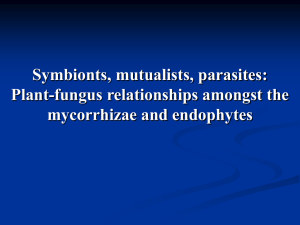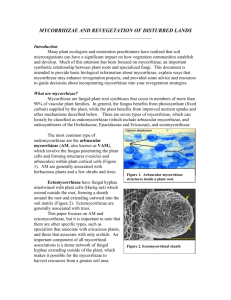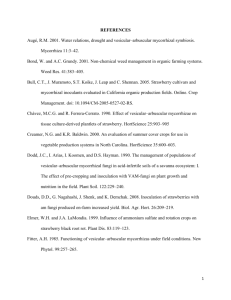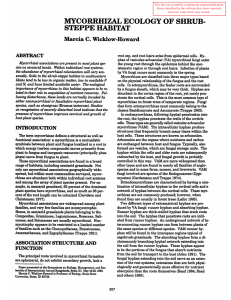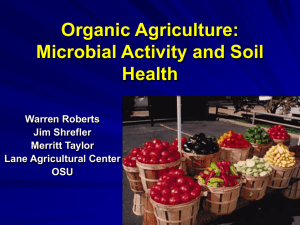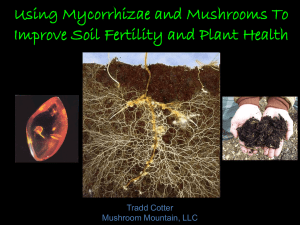Effects of Mycorrhizal Innoculation on Pea Growth
advertisement
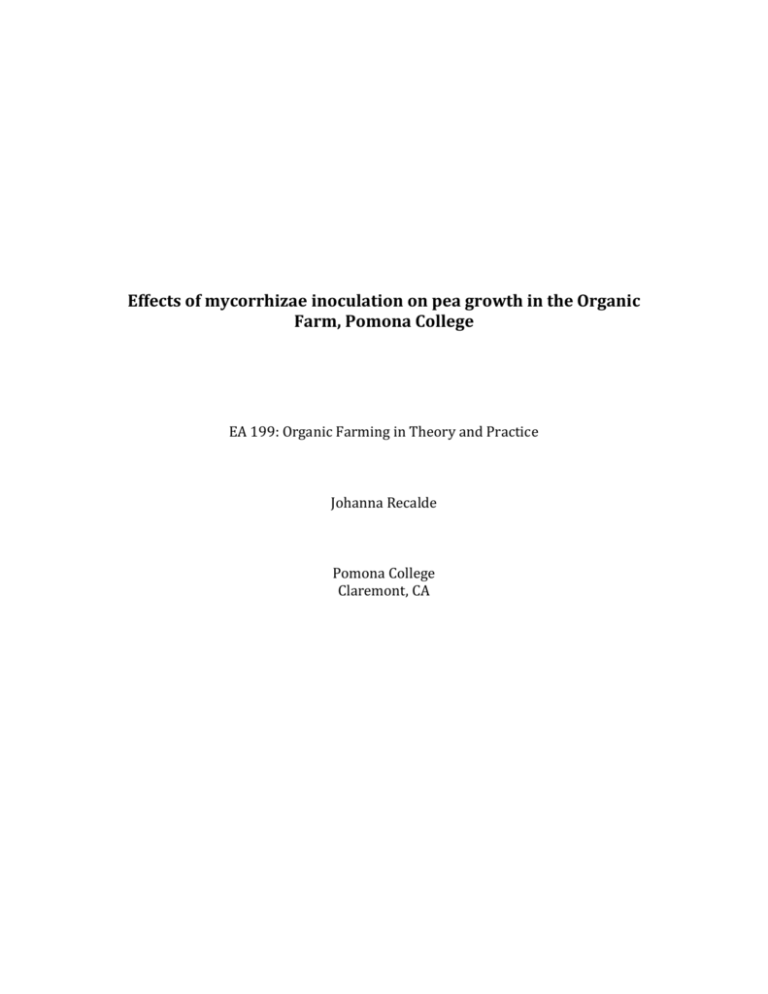
Effects of mycorrhizae inoculation on pea growth in the Organic Farm, Pomona College EA 199: Organic Farming in Theory and Practice Johanna Recalde Pomona College Claremont, CA INTRODUCTION Mycorrhizae are a symbiotic relationship between fungi and roots. About 80% of terrestrial plants have some kind of mycorrhizal association and there are thousands of different fungal species found all over the world (Richardson et al., 2000; Pringle et al., 2009). The symbiotic relationship between mycorrhizal fungi and roots occurs when the fungi provide roots with nutrients (such as organic nitrogen and phosphorus) and water in exchange for carbon exudates, though the benefits received by both the fungi and plant are species and context specific (Pringle et al., 2009). Since mycorrhizae can expand through the soil, the amount of nutrients and water gathered by mycorrhizae can prove to be necessary in certain resource deficient environments. Because of their importance on plant growth, mycorrhizae play an important role in agriculture. The use of mycorrhizal inoculant in agriculture can increase plant growth by up to 2,600% in citrus (Muchovej, 2001). The effects on other types of agricultural plants are also great. The use of mycorrhizae can also prevent the high use of fertilizers, since mycorrhizal inoculated plants have a decreased critical deficiency level of available nutrients, such as nitrogen and phosphorus (Muchovej, 2001). Apart from helping with plant growth, mycorrhizae can also help with soil stability and erosion control, which can be very important to certain geographic regions (Bethlenfalvay, 1992). Additioanlly, mycorrhizal associations can protect plants from soil pathogens and help with recovery from herbivory (Muchovej, 2001). The increased use of mycorrhizae can be very beneficial, not only in small farms, but in large industrial farms where the large use of fertilizers can be detrimental to different ecosystems. As far as I know, the use of mycorrhizae is only somewhat used in the Pomona Organic Farm. For mycorrhizae to be more widely used, there has to be an initiative to test its benefits in the specific environmental contexts of this small organic farm, to test whether it is a method that is worth investing in. PURPOSE The purpose of this experiment is to test if mycorrhizal inoculation improved the germination time and overall growth of mammoth melting sugar peas. By doing this in the Pomona Organic Farm, we can test how mycorrhizal can help given the relevant environmental conditions (such as alkine soil, low rainfall etc.) of Southern California. HYPOTHESIS AND PREDICTIONS I hypothesize that mycorrhizae will have a positive effect on the growth of the peas. I predict that seeds in mycorrhizal soil will germinate earlier and will grow quicker and taller than those on regular soil. MATERIALS AND METHODS This experiment was done in the Pomona Organic Farm, Pomona College. One soil bed was separated into 4, 2x2 ft. plots, with a 2 ft. buffer zone between the plots. The plots were organized in an alternating manner, with two experimental plots and two control plots. In the experimental plots, 3 tablespoons of mycorrhizal inoculant were added to the soil and mixed in by hand. Mammoth melting sugar pea seeds were planted in both the experimental and control plots in a circular manner, with some seeds planted in the middle as well. Twenty seeds were planted per plot and the bed was watered by a mechanized watering system. Data on the germination time was gathered during the first two weeks. Data on the height of the plant was also gathered for two weeks after initial germination. Germination success was measured by counting how many seeds out of the 20 initially planted germinated in each plot. Analysis on germination time and growth was done using one way ANOVA tests. RESULTS There was so significant difference in germination success (F1 = 0.4, p = 0.592) or germination time (F1 = 0.4, p = 0.592) between the two treatments. There was also no difference in total height at the end of the experiment between treatments (F1 = 1.54, p = 0.227). Though not statistically significant, there was a slight trend of mycorrhizal plants having some taller plants than the control group, though the sample size was too small to make any conclusive statements (Fig. 1). Fig. 1. Total heights for plants in the mycorrhizal and control treatments. DISCUSSION The results found in this very short experiment were not significant. There were many drawbacks that could have resulted in these results. For one, there was a very chilly period in Claremont, in which temperatures dropped below 30 ˚F during the night, possibly having negative effects on germination time and growth. Additionally, there were high levels of herbivory, with a lot of the plants having most of their leaves chewed off. Since the level of herbivory affected all the treatments, it became more difficult to quantify any differences in growth between the treatments. Though the results of this experiment were not conclusive, there remains a large amount of literature that supports the positive impact that mycorrhizae can have on a wide variety of plants. I recommend that more experiments like this one be carried out in the Pomona Organic farm, since the use of mycorrhizae can prove to be a great sustainable method used to improve yields and the quality of the produce. If done for a longer period of time and during the spring and summer seasons, results from experiments like this might be more conclusive. REFERENCES Bethlenfalvay, G.J. (1992) “Mycorrhizae in the agricultural plant-soil system.” Symbiosis 14:413-425. Muchovej, R.M. (2001) “Importance of mycorrhizae for agricultural crops.” Institute of Food and Agricultural Sciences, SS-AGR-170. Pringle, A., Bever, J.D., Gardes, M., Parrent, J.L., Rillig, M.C., Klironomos, J.N. (2009) “Mycorrhizal symbioses and plant invasions.” Annual Review of Ecology, Evolution and Systematics 40:699-715. Richardson, D.M., Allsopp, N., D’Antonion, C.M., Milton, S.J., Rejmanek, M. (2000) “Plant Invasions – the role of mutualism.” Biological Reviews of the Cambridge Philosophical Society 75:65-93. References
